Speckled dino spurs debate about ancient animals’ colors
Fossilized pigment pouches hint at ancient animals’ lives — but are open to interpretation
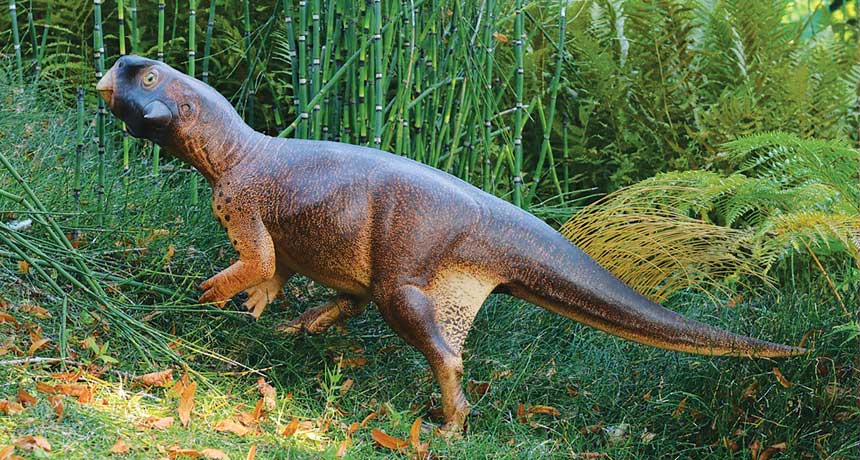
The plant-eating Psittacosaurus may have had a dark back and light belly, shown in this artist’s creation. The coloring could have acted as camouflage, helping the dinosaur hide in forested habitats.
J. Vinther/University of Bristol, Bob Nicholls/Paleocreations.com
By Meghan Rosen
Picture a dinosaur about the size of a golden retriever. Make it walk on two legs. Give it freckles. Then give it a dark back and a light belly. That’s a pretty good picture of one plant-eating dinosaur.
Named Psittacosaurus (Sit-TAK-uh-SOR-us), “It would have been a super-cute animal,” says Jakob Vinther. “It’s got this wide face and looks a little bit like E.T.”
A paleontologist, Vinther studies fossilized animals and plants. Over the past few years, he has become increasingly interested in the color of dinosaurs. So have other scientists. Now, there is a debate going on about just how much we know about what dinosaurs looked like and what their colors tell us about their lives.
The debate stems from the way scientists interpret certain structures that have been preserved in dinosaur fossils. Vinther and others say these structures could be the leftovers of ancient pigments. They are referring to pigment structures known as melanosomes (Meh-LAAN-oh-soams). These give color to skin, feathers and other tissues. They also might linger in fossil skin.
Finding ancient pigments in dinosaur fossils could open up a wide new world of dinosaur biology. For instance, it might answer all sorts of lifestyle questions, says Hannah Rowland. She is a zoologist, which means she studies animals, at the University of Cambridge, in England. “You might be able to take a fossil … and infer a dinosaur’s life history just from its pigment patterns,” she says. “That’s the most exciting thing.”
Not so fast, says Mary Schweitzer. She is a paleontologist at North Carolina State University in Raleigh. Evidence for ancient pigments can be hard to interpret. In some cases, microscopic structures that appear to be melanosomes may actually be microbes, she says. “Both hypotheses,” she says, “remain viable until one is shot down with data.” So for now, she argues, inferring dinosaur lifestyles from alleged ancient pigments is impossible.
From color to camouflage
That hasn’t stopped Vinther and others from trying. Psittacosaurus is the latest example.
The fossil is spectacular, Schweitzer says. “It’s got skin all over the place. I can’t think of too many dinosaur specimens that are preserved like this.”
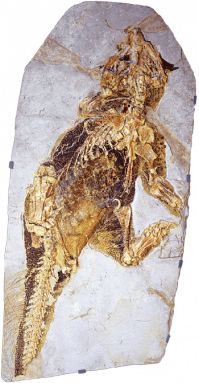
The fossil dinosaur lies on its back. It was flattened in a slab of volcanic rock. Skin covers a completely intact skeleton. Dozens of long bristles poke from its tail. The dino ate plants and lived some 120 million years ago. Walking on two legs, it would have stood some half meter (roughly 20 inches) tall.
Black material speckles the dinosaur’s body, tail and face. Vinther believes the material is the ancient remains of pigment — those melanosomes. His team examined samples chipped from the fossil. The researchers saw what seems to them the telltale orbs of melanosomes. The signs were mostly impressions in the rock. But there were some true 3-D structures too.
These structures are part of the reason the team believes the dinosaur was colored. It would have had a dark back that faded to a lighter belly, they say. That type of coloring is called countershading. From penguins to fish, it can serve as a type of camouflage. It lightens parts of the body typically in shadow. It darkens those parts typically exposed to light. “If you want to hide,” Rowland says, “it makes sense to try and obliterate those shadows.”
Vinther’s team also wanted to figure out where Psittacosaurus may have lived. So they crafted two life-size models of the dinosaur. One was painted with the color patterns inferred from the fossil. The other was made a uniform gray. The researchers then photographed the gray model in diffuse light. This is the type that would filter down through a forest. They photographed their models in direct light too. This is the type of direct sunlight that occurs on a prairie or a savanna.
Different lighting conditions made different shadow patterns on the model dinosaur’s body.
The team then figured out how to best disguise these patterns in the two different lighting scenarios. Their disguise for diffuse light matched the model painted like Psittacosaurus. “It’s like what we see in forest-living animals,” Vinther says. That’s why they now conclude: “This thing was camouflaged.”
Vinther published his team’s work on Psittacosaurus in the September 26 Current Biology. Their study, while exciting, has exposed pitfalls in research on paleo color. That is the study of fossil pigments and what they can reveal about ancient animals.
Still, the promise is clear: Paleo color could paint a vivid picture of a dinosaur’s life. It could offer clues about dinosaur behavior, habitat and evolution. “This is a crucial new piece in the puzzle of how the past looked,” Vinther claims.
Story continues below slideshow.


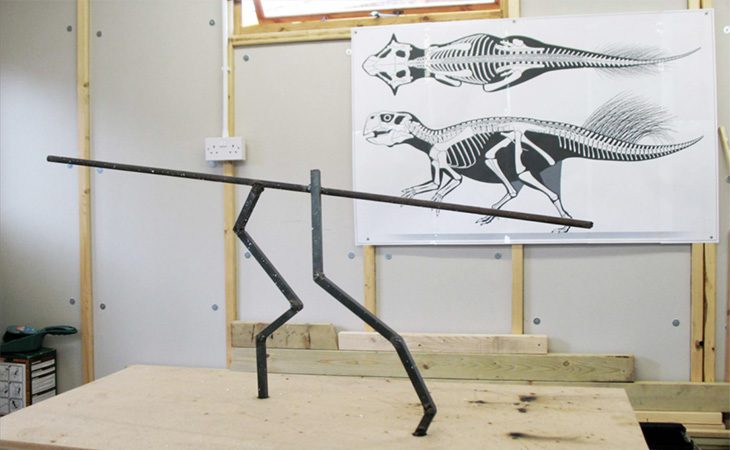
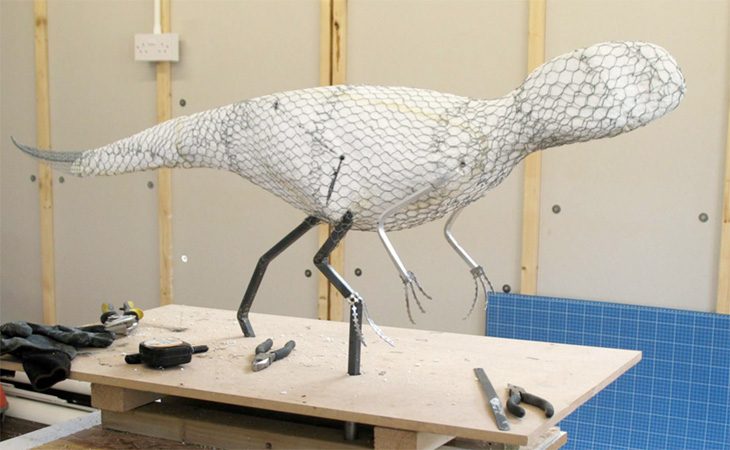
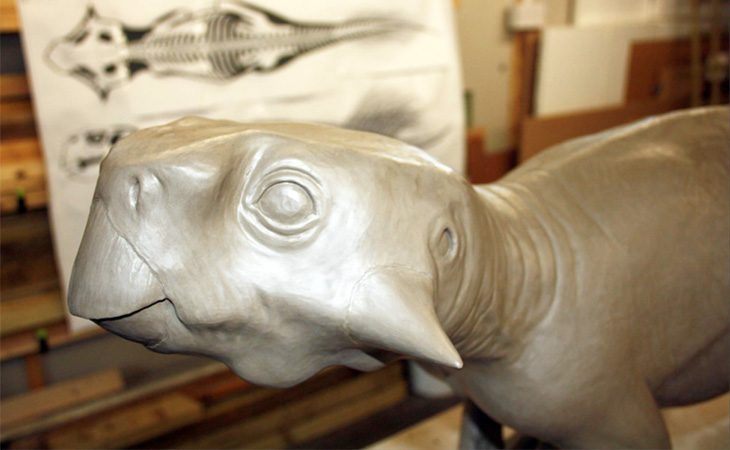
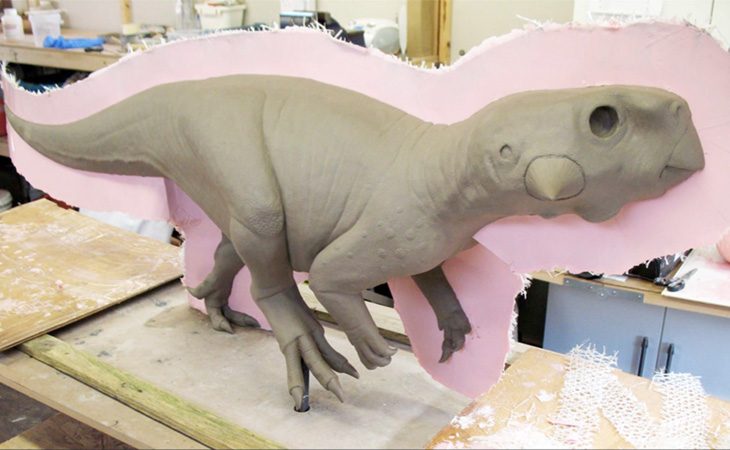
A field emerges
Paleontologists have been puzzling for centuries over what ancient animals might have looked like. Then, eight years ago, these scientists got a wake-up call. That’s when Vinther and his colleagues made a stunning suggestion. They had been looking at microscopic structures in a roughly 125-million-year-old fossil feather. The tiny structures, these researchers argued, were actually a type of melanosome. They claimed to see pigment pouches that rest inside pigment cells. In this particular fossil, the pigments might have given the feather a blackbird’s raven-like hue.
Scientists had noticed similar structures inside fossilized skin and feathers before. They had spied them since the early 1980s. But those scientists had assumed these structures were remnants of bacteria. Perhaps they were the remains of microbes that had feasted on the animal’s carcass, says Martin Sander. He is a paleontologist at the University of Bonn in Germany.
Then the new way of looking at things by Vinther’s team sparked a flurry of additional research. Scientists have since spotted what appear to be melanosomes in all types of fossilized animals. Paleontology, in fact, is now full of colors and patterns. For instance, pigment pods may have painted reddish-brown speckles upon the face of a dinosaur called Anchiornis huxleyi (AN-kee-OR-nis HUX-lee-eye).
Pigments appear to have painted chestnut stripes on a long-tailed dino from China. And they made the feathers iridescent on a four-winged dinosaur called Microraptor. (Iridescence is when an object seems to change color with a shift in the angle at which it is seen.) The shimmery dinosaur “probably had a weak, glossy iridescence all over its body,” concludes Matthew Shawkey. He is an evolutionary biologist at Ghent University in Belgium. His team deduced Microraptor’s color from the shape of its melanosomes.
Linking colors and shapes
Modern melanosomes generally carry a mixture of two pigments. Each is a type of melanin (MEL-uh-nin). A dark brown-black type is known as eumelanin (YOU-mel-uh-nin). The other, red-yellow version is called pheomelanin (FEE-oh-MEL-uh-nin). Scientists have also linked the colors in mammals and birds to a melanosome’s shape. A meatball shape points to reddish-brown hues. A sausage shape tends to provide darker colors.
In feathers that shimmer, melanosomes tend to be even thinner. Microraptor’s melanosomes looked like skinny sausages. They were similar to those seen in the feathers of modern crows and ravens, says Shawkey. He, Vinther and their team published these observations in Science four years ago.
Story continues below table.

Last year, Vinther laid out the case for inferring color — and ancient histories —from fossilized pigments. He published his ideas in a review in Bioessays. The distinctive shapes of melanosomes offer clues to color, he claimed. Chemical tests could also help detect the presence of melanin itself. To find this pigment in fossils, he argued, put the old bacteria hypothesis to bed.
Schweitzer’s group disagreed. They wrote a review published in Bioessays later in the year. Researchers need to be cautious, these scientists countered. Deducing the hues of extinct animals isn’t easy. Any melanosome look-alikes in fossil feathers or skin might actually be microbes, they argued. After all, microbes are everywhere.
“These animals died in an environment that was not sterile,” Schweitzer points out. “Think about it. If you take a piece of chicken and throw it out in your backyard, how long does it take for microbes to overgrow that chicken?”
Microbes are hardy, too. They and the sticky biofilms that they create can be preserved in fossils. Schweitzer also notes that microbes and melanosomes overlap completely in shape and size. That can make the two hard to tell apart. What’s more, some microbes actually make melanin. So finding the pigment in a fossil is not proof that the ancient critter was black, brown or freckled.
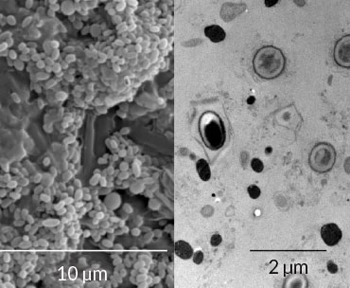
Johan Lindgren coauthored the Bioessays article with Schweitzer. A geologist at Lund University in Sweden, he has no doubt that melanosomes can leave traces in the fossil record. The issue, Lindgren says, is that not every round structure will be a melanosome.
Chemical tests could help distinguish one from the other. Bacteria, for instance, leave behind telltale traces. These can be identified with a specific type of chemical test. It uses high heat to break molecules down into smaller bits. A machine then determines the chemical composition of those bits.
But using this technique requires burning up the sample. “It can mean destroying much of what you are trying to study,” points out Roy Wogelius. He is a geologist at the University of Manchester in England. So this type of testing “is not always possible.”
Vinther’s new work is not likely to settle the debate. In fact, people argued both sides of the issue in October at a meeting in Salt Lake City of the Society of Vertebrate Paleontology.
Arindam Roy is a colleague of Vinther’s at Bristol. At that meeting, he reported size differences between fossilized melanosomes and the bacteria growing on decaying chicken feathers in the lab.
Alison Moyer said those observations weren’t enough, though. She is a colleague of Schweitzer’s at North Carolina State. She says keratin is key. Keratin is a protein that typically surrounds melanosomes. It, Moyer says, could serve as evidence for pigments in fossils.
Lingering doubts
Psittacosaurus’ skin very well may contain ancient pigments, Wogelius says. “I don’t think it’s a crazy idea.” However, he says of Vinther’s group: “I don’t think they’ve proved what they claim.”
Vinther’s team, for example, used just four tiny fossil samples to extrapolate the coloring of a whole dinosaur. “I think it’s a bit of an overreach,” Wogelius says.
Schweitzer also notes that the specimen had been varnished. That means it probably had been painted with some type of gloss. This likely was done to protect the fossil. It happened before Vinther and colleagues got their hands on the dinosaur. That gloss now makes it impossible to perform the chemical tests that would bolster any claim for pigments.
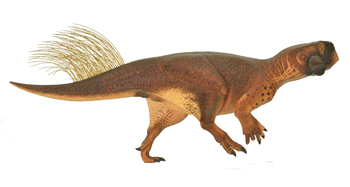
“Varnish is horribly destructive to fossils,” Schweitzer says. “It totally ruins the specimen for other types of analysis.”
Vinther argues that his team has chemically analyzed other fossils and found evidence of melanin — not bacteria. And, he adds, the structures in those fossils look just like the ones in Psittacosaurus.
Vinther’s team also saw evidence of just one kind of micro-structure. It had a quite round shape. If these structures were actually bacteria, he says, you’d expect to see a whole range of shapes and sizes. “Some of them would be shaped like corkscrews. Some would have flagella. Some would be humongous. Some would be tiny.”
Not necessarily, counters Lindgren. That’s the tricky thing with bacteria. “In some cases you can have a huge consortium,” she says, meaning lots of varied types. “In other cases you can have one single type.”
But you don’t have to rely on that argument alone, a new study finds. It has just turned up melanosomes and beta keratin — a protein in the stringy matrix that surrounds melanosomes. “Identifying keratin is key to ruling out a microbial source,” write Mary Schweitzer and her colleagues.
This newest report appeared online November 21 in the Proceedings of the National Academy of Sciences.
Schweitzer’s team had been examining feathers from a 130-million-year-old bird known as Eoconfuciusornis (EE-oh-kon-few-shious-SOR-nis). And this group, too, found round, 3-D structures.
The authors won’t speculate on the ancient bird’s color. They do, however, argue that the beta keratin offers a new way to support claims of finding ancient pigments.
More research hoped for
Vinther’s argument that he’s found melanosomes certainly has its backers. “I was skeptical at first,” says the University of Bonn’s Sander. “But now there’s been such an array of these little [structures] that it’s pretty clear that at least some of them are not bacteria.” Despite some continuing controversy, he says many paleontologists now accept that some fossil microstructures may be melanosomes.
More research, though, would help remove “any lingering doubts,” he says.
Along with chemical tests, Schweitzer suggests, researchers could try transmission electron microscopy (TEM). This technique blasts an electron beam through a thinly sliced sample. With TEM, melanosomes appear as black blobs. Bacteria tend to look quite different — in some cases, like fried eggs.
Ghent University’s Shawkey is instead focusing on chemistry. He published a paper online November 14 in Palaeontology. In it, his team used a technique called Raman spectroscopy. This method helps produce a chemical fingerprint of a sample.
These researchers used the tool to help build a case for feather coloring. They were looking at feathers from a bird that died some 120 million years ago. The researchers spotted skinny sausages in the feathers. These are a tell-tale sign of iridescent melanosomes. There also was evidence of the pigment eumelanin.
No doubt, the field of paleo color has its snags. But the emerging work may mean paleontologists can begin to fill in the hues and tints of ancient animals. And that might one day reveal the habits and habitats of creatures that, until recently, had been known almost exclusively by their bones and teeth.







